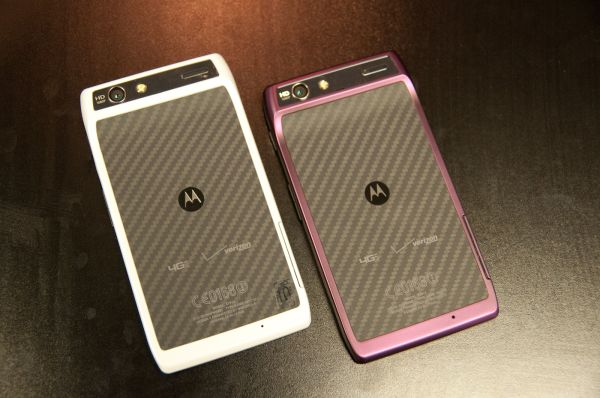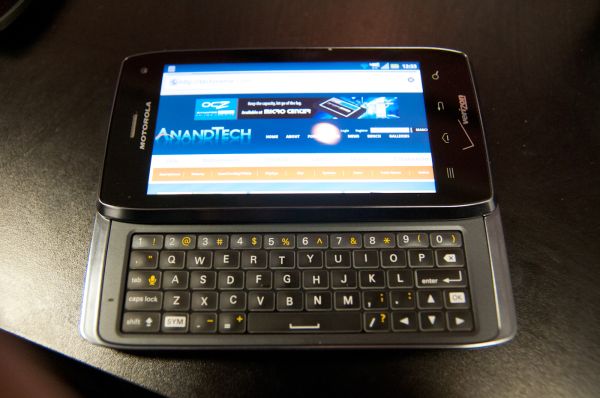Motorola Droid RAZR MAXX, Droid 4, and Lapdock 500 Pro Impressions
by Brian Klug on January 12, 2012 10:02 PM EST- Posted in
- Trade Shows
- CES
- Motorola
- CES 2012
- Droid 4
- RAZR MAXX
- Lapdock 500
Anand and I stopped by Motorola this afternoon and got to spend some time with a number of the handset-maker's newly announced products, including the RAZR MAXX, Droid 4, and Lapdock 500 Pro. We covered the announcement, but as a refresher, the RAZR MAXX is a RAZR with a gargantuan 3300 mAh (12.54 Whr) battery and slightly thicker profile, and the Droid 4 is a close relative that eschews the SAMOLED Advanced display for TFT-LCD and includes a 5-row QWERTY keyboard. Both include 4G LTE connectivity and a 1.2 GHz OMAP4430 SoC.
When playing with the RAZR MAXX, it's shocking how a phone with this large of a battery manages to not feel strangely heavy or bulky. Like a number of other Motorola devices, the RAZR MAXX's internal battery is also the higher voltage 3.8V nominal chemistry as well. The MAXX simply closes the thickness difference between the camera bulge and the backside and instead results in a flat surface. The best way to think of it is that the thickest part of the RAZR is no thicker on the MAXX, only the thinner carbon-fiber region puts on some bulk. I'm excited to see how the MAXX does in our battery life tests with that big of a battery.
Motorola also whipped out the purple RAZR which we grabbed some shots of. The white and purple RAZRs are identical to the gunmetal grey device we've already reviewed.
The Droid 4 looks and feels a lot like the RAZR, and doesn't bulk up that much with the addition of a QWERTY keyboard. I came away very impressed with the Droid 4's keyboard, which felt very communicative and comfortable, just like the Droid 3's. The Droid 4 includes a LCD-TFT with RGBW PenTile instead of the RAZR's RGBG Super AMOLED Advanced.
Lastly, we got a brief chance to touch and inspect the Lapdock 500 Pro, which feels like a much more serious, grown up, evenly-balanced notebook than the Lapdock 100. In addition, the Lapdock 500 Pro includes many more I/O options, including Ethernet, D-Sub, an SD card slot, and front facing camera.




















15 Comments
View All Comments
piroroadkill - Friday, January 13, 2012 - link
Now, other manufacturers take note.They removed the contoured bulge and filled it out. I think it even looks better, and 3300 mAh, well, Jesus Christ.
We've been saying (that is almost anyone, ever, on all forums) that they should make phones a little thicker, throw a flat battery all over the back of the phone, and give us dumb-phone like battery life.
Finally.
Omega215D - Friday, January 13, 2012 - link
I always did find the bump in the back of the phone to be a bit annoying and always did want them to fill it out with an extended battery like you could with the Droid X/ X2.I would find this phone to be more comfortable to handle compared to the Droid Razr and never really saw the need for super thin phones, especially if they're pretty wide.
The Droid 4 has my interest though. The keyboard looks like it's got some bumps to it and I did like the keyboard on my OG Droid. As a bonus the phone has global roaming capabilities and a decent resolution. Hopefully battery life measures up.
Myrandex - Friday, January 13, 2012 - link
I agree the keyboard looks quite interesting.The problem, as least it was the problem in the past, is Verizon locking out the sim card slot from U.S. carriers. I wouldn't give anyone money for doing actions like that.
This keybaord does look close to approaching the legendary HTC Touch Pro 2 keyboard, which unfortuantely do this day I haven't found a keyboard as good as that ever since its release.
Jason
jhoff80 - Friday, January 13, 2012 - link
Really, a Pentile LCD? That's a new one, I thought that was only for AMOLED.themossie - Saturday, January 14, 2012 - link
Unfortunately, not a new one - in fact, this looks like the same display the Motorola Bionic and Droid 3 used, and the worst Pentile screen I've ever abused my eyes on.Adding the white subpixel to LCDs gives many of the advantages of AMOLED (individual pixel backlighting, saving power and improving contrast) at a lower cost. Combined with the normal LED backlighting, this can drastically improve maximum brightness.
Once they bump up the resolution further, Pentile will not affect sensitive people like me :-) I'll still take a lower-res RGB stripe screen any day.